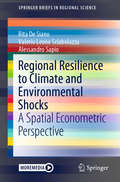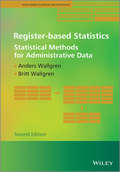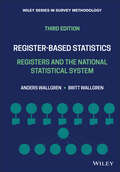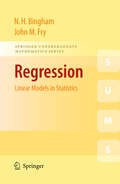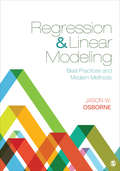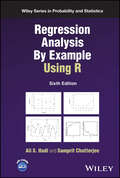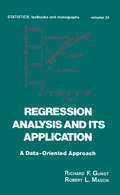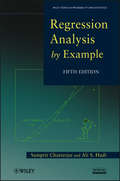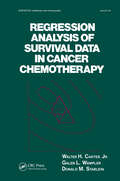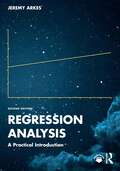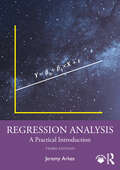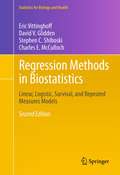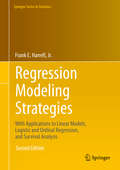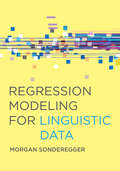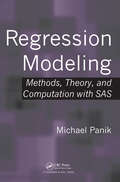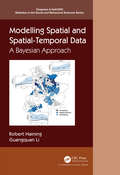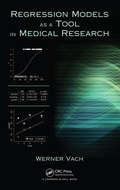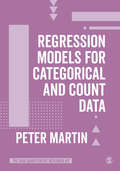- Table View
- List View
Regional Resilience to Climate and Environmental Shocks: A Spatial Econometric Perspective (SpringerBriefs in Regional Science)
by Rita De Siano Valerio Leone Sciabolazza Alessandro SapioThe book illustrates the use of spatial econometric models to analyze the economic resilience of regions to climate-related shocks. Although climate change is a global externality, climate anomalies can trigger locally disruptive shocks, whose adverse effects on economic growth are transmitted through neighbouring relationships (based on geography, trade, or technological bonds). After laying out the theoretical case for spatial analysis in the study of economic resilience, the book introduces spatial econometric models, their estimation and testing procedures, as well as applications of spatial econometrics in various domains. It then reviews the current literature on the role of space in the propagation of climate shocks, and discusses how adaptation and mitigation policies can leverage spatial dependencies, with a special focus on renewable energy technologies and agricultural productivity. It appeals to scholars of regional and spatial sciences and econometrics as well as those interested in the spatial effects of climate and environmental shocks.
Register-based Statistics
by Britt Wallgren Anders WallgrenThis book provides a comprehensive and up to date treatment of theory and practical implementation in Register-based statistics. It begins by defining the area, before explaining how to structure such systems, as well as detailing alternative approaches. It explains how to create statistical registers, how to implement quality assurance, and the use of IT systems for register-based statistics. Further to this, clear details are given about the practicalities of implementing such statistical methods, such as protection of privacy and the coordination and coherence of such an undertaking.This edition offers a full understanding of both the principles and practices of this increasingly popular area of statistics, and can be considered a first step to a more systematic way of working with register-statistical issues. This book addresses the growing global interest in the topic and employs a much broader, more international approach than the 1st edition. New chapters explore different kinds of register-based surveys, such as preconditions for register-based statistics and comparing sample survey and administrative data. Furthermore, the authors present discussions on register-based census, national accounts and the transition towards a register-based system as well as presenting new chapters on quality assessment of administrative sources and production process quality.
Register-based Statistics: Registers and the National Statistical System (Wiley Series in Survey Methodology)
by Britt Wallgren Anders WallgrenREGISTER-BASED STATISTICS Rediscover this authoritative guide to register-based statistics filled with significant new improvements In the newly revised Third Edition of Register-based Statistics: Registers and the National Statistical System, Anders Wallgren and Britt Wallgren deliver a robust exploration of how register-based statistics can be used to its fullest potential. The authors describe how statistical institutes can work on long-term projects to improve administrative systems, as well as estimation methods that can improve the quality of statistical estimates based on registers with quality problems. Readers will also discover how to improve the ways register-statistical issues are introduced, as well as how to create population registers. Finally, the authors draw on their experience from teaching and consulting in several countries to explain how to implement register-based statistics. Key features of the third edition: Discusses the problems new register countries face Explains how registers will improve the efficiency of the national statistical system Clarifies the importance of the system approach Describes how a statistical population register can be created Registers-based statistics require new skills and understanding of new concepts Many important quality indicators are described Explains difficult topics in a pedagogic way Perfect for staff at national statistical institutes and administrative and ministerial authorities belonging to national statistical systems, Register-based Statistics will also prove to be an indispensable resource for undergraduate and graduate students in statistics programs and courses, as well as survey researchers and practitioners.
Regression
by John M. Fry N. H. BinghamRegression is the branch of Statistics in which a dependent variable of interest is modelled as a linear combination of one or more predictor variables, together with a random error. The subject is inherently two- or higher- dimensional, thus an understanding of Statistics in one dimension is essential. Regression: Linear Models in Statistics fills the gap between introductory statistical theory and more specialist sources of information. In doing so, it provides the reader with a number of worked examples, and exercises with full solutions. The book begins with simple linear regression (one predictor variable), and analysis of variance (ANOVA), and then further explores the area through inclusion of topics such as multiple linear regression (several predictor variables) and analysis of covariance (ANCOVA). The book concludes with special topics such as non-parametric regression and mixed models, time series, spatial processes and design of experiments. Aimed at 2nd and 3rd year undergraduates studying Statistics, Regression: Linear Models in Statistics requires a basic knowledge of (one-dimensional) Statistics, as well as Probability and standard Linear Algebra. Possible companions include John Haigh's Probability Models, and T. S. Blyth & E.F. Robertsons' Basic Linear Algebra and Further Linear Algebra.
Regression & Linear Modeling: Best Practices and Modern Methods
by Jason W. OsborneIn a conversational tone, Regression & Linear Modeling provides conceptual, user-friendly coverage of the generalized linear model (GLM). Readers will become familiar with applications of ordinary least squares (OLS) regression, binary and multinomial logistic regression, ordinal regression, Poisson regression, and loglinear models. Author Jason W. Osborne returns to certain themes throughout the text, such as testing assumptions, examining data quality, and, where appropriate, nonlinear and non-additive effects modeled within different types of linear models.
Regression & Linear Modeling: Best Practices and Modern Methods
by Jason W. OsborneIn a conversational tone, Regression & Linear Modeling provides conceptual, user-friendly coverage of the generalized linear model (GLM). Readers will become familiar with applications of ordinary least squares (OLS) regression, binary and multinomial logistic regression, ordinal regression, Poisson regression, and loglinear models. Author Jason W. Osborne returns to certain themes throughout the text, such as testing assumptions, examining data quality, and, where appropriate, nonlinear and non-additive effects modeled within different types of linear models.
Regression Analysis By Example Using R (Wiley Series in Probability and Statistics)
by Samprit Chatterjee Ali S. HadiRegression Analysis By Example Using R A STRAIGHTFORWARD AND CONCISE DISCUSSION OF THE ESSENTIALS OF REGRESSION ANALYSIS In the newly revised sixth edition of Regression Analysis By Example Using R, distinguished statistician Dr Ali S. Hadi delivers an expanded and thoroughly updated discussion of exploratory data analysis using regression analysis in R. The book provides in-depth treatments of regression diagnostics, transformation, multicollinearity, logistic regression, and robust regression. The author clearly demonstrates effective methods of regression analysis with examples that contain the types of data irregularities commonly encountered in the real world. This newest edition also offers a brand-new, easy to read chapter on the freely available statistical software package R. Readers will also find: Reorganized, expanded, and upgraded exercises at the end of each chapter with an emphasis on data analysis Updated data sets and examples throughout the book Complimentary access to a companion website that provides data sets in xlsx, csv, and txt format Perfect for upper-level undergraduate or beginning graduate students in statistics, mathematics, biostatistics, and computer science programs, Regression Analysis By Example Using R will also benefit readers who need a reference for quick updates on regression methods and applications.
Regression Analysis Under A Priori Parameter Restrictions
by Pavel S. Knopov Arnold S. KorkhinThis monograph focuses on the construction of regression models with linear and non-linear constrain inequalities from the theoretical point of view. Unlike previous publications, this volume analyses the properties of regression with inequality constrains, investigating the flexibility of inequality constrains and their ability to adapt in the presence of additional a priori information The implementation of inequality constrains improves the accuracy of models, and decreases the likelihood of errors. Based on the obtained theoretical results, a computational technique for estimation and prognostication problems is suggested. This approach lends itself to numerous applications in various practical problems, several of which are discussed in detail The book is useful resource for graduate students, PhD students, as well as for researchers who specialize in applied statistics and optimization. This book may also be useful to specialists in other branches of applied mathematics, technology, econometrics and finance
Regression Analysis and its Application: A Data-Oriented Approach (Statistics: Textbooks and Monographs #34)
by Richard F. Gunst Robert L. MasonRegression Analysis and Its Application: A Data-Oriented Approach answers the need for researchers and students who would like a better understanding of classical regression analysis. Useful either as a textbook or as a reference source, this book bridges the gap between the purely theoretical coverage of regression analysis and its practical application. The book presents regression analysis in the general context of data analysis. Using a teach-by-example format, it contains ten major data sets along with several smaller ones to illustrate the common characteristics of regression data and properties of statistics that are employed in regression analysis. The book covers model misspecification, residual analysis, multicollinearity, and biased regression estimators. It also focuses on data collection, model assumptions, and the interpretation of parameter estimates.Complete with an extensive bibliography, Regression Analysis and Its Application is suitable for statisticians, graduate and upper-level undergraduate students, and research scientists in biometry, business, ecology, economics, education, engineering, mathematics, physical sciences, psychology, and sociology. In addition, data collection agencies in the government and private sector will benefit from the book.
Regression Analysis by Example
by Samprit Chatterjee Ali S. HadiPraise for the Fourth Edition:"This book is . . . an excellent source of examples for regression analysis. It has been and still is readily readable and understandable."--Journal of the American Statistical Association Regression analysis is a conceptually simple method for investigating relationships among variables. Carrying out a successful application of regression analysis, however, requires a balance of theoretical results, empirical rules, and subjective judgment. Regression Analysis by Example, Fifth Edition has been expanded and thoroughly updated to reflect recent advances in the field. The emphasis continues to be on exploratory data analysis rather than statistical theory. The book offers in-depth treatment of regression diagnostics, transformation, multicollinearity, logistic regression, and robust regression.The book now includes a new chapter on the detection and correction of multicollinearity, while also showcasing the use of the discussed methods on newly added data sets from the fields of engineering, medicine, and business. The Fifth Edition also explores additional topics, including:Surrogate ridge regressionFitting nonlinear modelsErrors in variablesANOVA for designed experimentsMethods of regression analysis are clearly demonstrated, and examples containing the types of irregularities commonly encountered in the real world are provided. Each example isolates one or two techniques and features detailed discussions, the required assumptions, and the evaluated success of each technique. Additionally, methods described throughout the book can be carried out with most of the currently available statistical software packages, such as the software package R.Regression Analysis by Example, Fifth Edition is suitable for anyone with an understanding of elementary statistics.
Regression Analysis of Count Data
by A. Colin Cameron Pravin K. TrivediStudents in both social and natural sciences often seek regression methods to explain the frequency of events, such as visits to a doctor, auto accidents, or new patents awarded. This book provides the most comprehensive and up-to-date account of models and methods to interpret such data. The authors have conducted research in the field for more than twenty-five years. In this book, they combine theory and practice to make sophisticated methods of analysis accessible to researchers and practitioners working with widely different types of data and software in areas such as applied statistics, econometrics, marketing, operations research, actuarial studies, demography, biostatistics, and quantitative social sciences. The book may be used as a reference work on count models or by students seeking an authoritative overview. Complementary material in the form of data sets, template programs, and bibliographic resources can be accessed on the Internet through the authors' homepages. This second edition is an expanded and updated version of the first, with new empirical examples and more than one hundred new references added. The new material includes new theoretical topics, an updated and expanded treatment of cross-section models, coverage of bootstrap-based and simulation-based inference, expanded treatment of time series, multivariate and panel data, expanded treatment of endogenous regressors, coverage of quantile count regression, and a new chapter on Bayesian methods.
Regression Analysis of Survival Data in Cancer Chemotherapy (Statistics: A Series of Textbooks and Monographs)
by Walter H. Carter Jr. Galen L. Wampler Doanld M. StableinThis book presents ideas and procedures for regression analysis of survival data in cancer chemotherapy based on regression-based approaches for improvements in the quality of care through the effective location of optimal treatment levels. It is useful for cancer chemotherapists.
Regression Analysis: A Practical Introduction
by Jeremy ArkesThis thoroughly practical and engaging textbook is designed to equip students with the skills needed to undertake sound regression analysis without requiring high-level math. Regression Analysis covers the concepts needed to design optimal regression models and to properly interpret regressions. It details the most common pitfalls, including three sources of bias not covered in other textbooks. Rather than focusing on equations and proofs, the book develops an understanding of these biases visually and with examples of situations in which such biases could arise. In addition, it describes how ‘holding other factors constant’ actually works and when it does not work. This second edition features a new chapter on integrity and ethics, and has been updated throughout to include more international examples. Each chapter offers examples, exercises, and clear summaries, all of which are designed to support student learning to help towards producing responsible research. This is the textbook the author wishes he had learned from, as it would have helped him avoid many research mistakes he made in his career. It is ideal for anyone learning quantitative methods in the social sciences, business, medicine, and data analytics. It will also appeal to researchers and academics looking to better understand regressions. Additional digital supplements are available at: www.youtube.com/channel/UCenm3BWqQyXA2JRKB_QXGyw.
Regression Analysis: A Practical Introduction
by Jeremy ArkesThis thoroughly practical and engaging textbook conveys the skills needed to responsibly develop, conduct, scrutinize, and interpret statistical analyses, without requiring any high-level math.Regression Analysis details the most common sources of statistical biases, including some not covered in other textbooks. Rather than focusing on complicated equations, the book describes these biases visually and with examples of situations in which they could arise. As the author argues, just learning how to conduct regressions without learning how to properly assess and interpret regressions can do more harm than good. Other unique features include an innovative approach to describing the elusive concept of "holding other factors constant" and proper interpretations of the strength of evidence in light of the Bayesian critique of hypothesis testing. This third edition enhances the emphasis on ethical and responsible research practices and creates more examples demonstrating how the biases and their corrections could affect the regression results.This is the textbook the author wishes he had learned from, as it would have helped him avoid many research mistakes he made in his career at research organizations and in academia. It is ideal for undergraduate and postgraduate students learning quantitative methods in the social sciences, business, medicine, and data analytics. It will also appeal to researchers and academics looking to better understand regressions.
Regression Diagnostics: An Introduction (Quantitative Applications in the Social Sciences #79)
by Dr. John FoxRegression diagnostics are methods for determining whether a regression model that has been fit to data adequately represents the structure of the data. For example, if the model assumes a linear (straight-line) relationship between the response and an explanatory variable, is the assumption of linearity warranted? Regression diagnostics not only reveal deficiencies in a regression model that has been fit to data but in many instances may suggest how the model can be improved. The Second Edition of this bestselling volume by John Fox considers two important classes of regression models: the normal linear regression model (LM), in which the response variable is quantitative and assumed to have a normal distribution conditional on the values of the explanatory variables; and generalized linear models (GLMs) in which the conditional distribution of the response variable is a member of an exponential family. R code and data sets for examples within the text can be found on an accompanying website at https://tinyurl.com/RegDiag.
Regression Diagnostics: An Introduction (Quantitative Applications in the Social Sciences #79)
by Dr. John FoxRegression diagnostics are methods for determining whether a regression model that has been fit to data adequately represents the structure of the data. For example, if the model assumes a linear (straight-line) relationship between the response and an explanatory variable, is the assumption of linearity warranted? Regression diagnostics not only reveal deficiencies in a regression model that has been fit to data but in many instances may suggest how the model can be improved. The Second Edition of this bestselling volume by John Fox considers two important classes of regression models: the normal linear regression model (LM), in which the response variable is quantitative and assumed to have a normal distribution conditional on the values of the explanatory variables; and generalized linear models (GLMs) in which the conditional distribution of the response variable is a member of an exponential family. R code and data sets for examples within the text can be found on an accompanying website at https://tinyurl.com/RegDiag.
Regression Methods in Biostatistics
by Eric Vittinghoff Stephen C. Shiboski Charles E. Mcculloch David V. GliddenThis new book provides a unified, in-depth, readable introduction to the multipredictor regression methods most widely used in biostatistics: linear models for continuous outcomes, logistic models for binary outcomes, the Cox model for right-censored survival times, repeated-measures models for longitudinal and hierarchical outcomes, and generalized linear models for counts and other outcomes. Treating these topics together takes advantage of all they have in common. The authors point out the many-shared elements in the methods they present for selecting, estimating, checking, and interpreting each of these models. They also show that these regression methods deal with confounding, mediation, and interaction of causal effects in essentially the same way. The examples, analyzed using Stata, are drawn from the biomedical context but generalize to other areas of application. While a first course in statistics is assumed, a chapter reviewing basic statistical methods is included. Some advanced topics are covered but the presentation remains intuitive. A brief introduction to regression analysis of complex surveys and notes for further reading are provided.
Regression Modeling Strategies
by Jr. Frank E. HarrellThis highly anticipated second edition features new chapters and sections, 225 new references, and comprehensive R software. In keeping with the previous edition, this book is about the art and science of data analysis and predictive modeling, which entails choosing and using multiple tools. Instead of presenting isolated techniques, this text emphasizes problem solving strategies that address the many issues arising when developing multivariable models using real data and not standard textbook examples. It includes imputation methods for dealing with missing data effectively, methods for fitting nonlinear relationships and for making the estimation of transformations a formal part of the modeling process, methods for dealing with "too many variables to analyze and not enough observations," and powerful model validation techniques based on the bootstrap. The reader will gain a keen understanding of predictive accuracy and the harm of categorizing continuous predictors or outcomes. This text realistically deals with model uncertainty and its effects on inference, to achieve "safe data mining. " It also presents many graphical methods for communicating complex regression models to non-statisticians. Regression Modeling Strategies presents full-scale case studies of non-trivial datasets instead of over-simplified illustrations of each method. These case studies use freely available R functions that make the multiple imputation, model building, validation and interpretation tasks described in the book relatively easy to do. Most of the methods in this text apply to all regression models, but special emphasis is given to multiple regression using generalized least squares for longitudinal data, the binary logistic model, models for ordinal responses, parametric survival regression models and the Cox semi parametric survival model. A new emphasis is given to the robust analysis of continuous dependent variables using ordinal regression. As in the first edition, this text is intended for Masters' or Ph. D. level graduate students who have had a general introductory probability and statistics course and who are well versed in ordinary multiple regression and intermediate algebra. The book will also serve as a reference for data analysts and statistical methodologists, as it contains an up-to-date survey and bibliography of modern statistical modeling techniques. Examples used in the text mostly come from biomedical research, but the methods are applicable anywhere predictive models ("analytics") are useful, including economics, epidemiology, sociology, psychology, engineering and marketing.
Regression Modeling for Linguistic Data
by Morgan SondereggerThe first comprehensive textbook on regression modeling for linguistic data offers an incisive conceptual overview along with worked examples that teach practical skills for realistic data analysis.In the first comprehensive textbook on regression modeling for linguistic data in a frequentist framework, Morgan Sonderegger provides graduate students and researchers with an incisive conceptual overview along with worked examples that teach practical skills for realistic data analysis. The book features extensive treatment of mixed-effects regression models, the most widely used statistical method for analyzing linguistic data. Sonderegger begins with preliminaries to regression modeling: assumptions, inferential statistics, hypothesis testing, power, and other errors. He then covers regression models for non-clustered data: linear regression, model selection and validation, logistic regression, and applied topics such as contrast coding and nonlinear effects. The last three chapters discuss regression models for clustered data: linear and logistic mixed-effects models as well as model predictions, convergence, and model selection. The book&’s focused scope and practical emphasis will equip readers to implement these methods and understand how they are used in current work.The only advanced discussion of modeling for linguistsUses R throughout, in practical examples using real datasetsExtensive treatment of mixed-effects regression modelsContains detailed, clear guidance on reporting modelsEqual emphasis on observational data and data from controlled experimentsSuitable for graduate students and researchers with computational interests across linguistics and cognitive science
Regression Modeling with Actuarial and Financial Applications
by Edward W. FreesStatistical techniques can be used to address new situations. This is important in a rapidly evolving risk management and financial world. Analysts with a strong statistical background understand that a large data set can represent a treasure trove of information to be mined and can yield a strong competitive advantage. This book provides budding actuaries and financial analysts with a foundation in multiple regression and time series. Readers will learn about these statistical techniques using data on the demand for insurance, lottery sales, foreign exchange rates, and other applications. Although no specific knowledge of risk management or finance is presumed, the approach introduces applications in which statistical techniques can be used to analyze real data of interest. In addition to the fundamentals, this book describes several advanced statistical topics that are particularly relevant to actuarial and financial practice, including the analysis of longitudinal, two-part (frequency/severity), and fat-tailed data. Datasets with detailed descriptions, sample statistical software scripts in "R" and "SAS," and tips on writing a statistical report, including sample projects, can be found on the book's Web site: http://research. bus. wisc. edu/RegActuaries.
Regression Modeling: Methods, Theory, and Computation with SAS
by Michael PanikRegression Modeling: Methods, Theory, and Computation with SAS provides an introduction to a diverse assortment of regression techniques using SAS to solve a wide variety of regression problems. The author fully documents the SAS programs and thoroughly explains the output produced by the programs.The text presents the popular ordinary least square
Regression Modelling wih Spatial and Spatial-Temporal Data: A Bayesian Approach (Chapman & Hall/CRC Statistics in the Social and Behavioral Sciences)
by Robert P. Haining Guangquan LiModelling Spatial and Spatial-Temporal Data: A Bayesian Approach is aimed at statisticians and quantitative social, economic and public health students and researchers who work with spatial and spatial-temporal data. It assumes a grounding in statistical theory up to the standard linear regression model. The book compares both hierarchical and spatial econometric modelling, providing both a reference and a teaching text with exercises in each chapter. The book provides a fully Bayesian, self-contained, treatment of the underlying statistical theory, with chapters dedicated to substantive applications. The book includes WinBUGS code and R code and all datasets are available online. Part I covers fundamental issues arising when modelling spatial and spatial-temporal data. Part II focuses on modelling cross-sectional spatial data and begins by describing exploratory methods that help guide the modelling process. There are then two theoretical chapters on Bayesian models and a chapter of applications. Two chapters follow on spatial econometric modelling, one describing different models, the other substantive applications. Part III discusses modelling spatial-temporal data, first introducing models for time series data. Exploratory methods for detecting different types of space-time interaction are presented followed by two chapters on the theory of space-time separable (without space-time interaction) and inseparable (with space-time interaction) models. An applications chapter includes: the evaluation of a policy intervention; analysing the temporal dynamics of crime hotspots; chronic disease surveillance; and testing for evidence of spatial spillovers in the spread of an infectious disease. A final chapter suggests some future directions and challenges.
Regression Models as a Tool in Medical Research
by Werner VachWhile regression models have become standard tools in medical research, understanding how to properly apply the models and interpret the results is often challenging for beginners. This text presents the fundamental concepts and important aspects of regression models most commonly used in medical research, including the classical regression model for continuous outcomes, the logistic regression model for binary outcomes, and the Cox proportional hazards model for survival data. The author emphasizes adequate use, correct interpretation of results, appropriate presentation of results, and avoidance of potential pitfalls.
Regression Models for Categorical and Count Data (The SAGE Quantitative Research Kit)
by Peter MartinThis text provides practical guidance on conducting regression analysis on categorical and count data. Step by step and supported by lots of helpful graphs, it covers both the theoretical underpinnings of these methods as well as their application, giving you the skills needed to apply them to your own research. It offers guidance on: · Using logistic regression models for binary, ordinal, and multinomial outcomes · Applying count regression, including Poisson, negative binomial, and zero-inflated models · Choosing the most appropriate model to use for your research · The general principles of good statistical modelling in practice Part of The SAGE Quantitative Research Kit, this book will give you the know-how and confidence needed to succeed on your quantitative research journey
Regression Models for Categorical and Count Data (The SAGE Quantitative Research Kit)
by Peter MartinThis text provides practical guidance on conducting regression analysis on categorical and count data. Step by step and supported by lots of helpful graphs, it covers both the theoretical underpinnings of these methods as well as their application, giving you the skills needed to apply them to your own research. It offers guidance on: · Using logistic regression models for binary, ordinal, and multinomial outcomes · Applying count regression, including Poisson, negative binomial, and zero-inflated models · Choosing the most appropriate model to use for your research · The general principles of good statistical modelling in practice Part of The SAGE Quantitative Research Kit, this book will give you the know-how and confidence needed to succeed on your quantitative research journey
